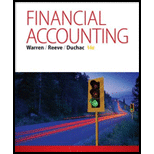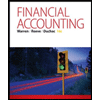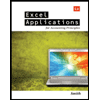
1.
Prepare
1.
Explanation of Solution
Bonds: Bonds are long-term promissory notes that are represented by a company while borrowing money from investors to raise fund for financing the operations.
Bonds Payable: Bonds payable are referred to long-term debts of the business, issued to various lenders known as bondholders, generally in multiples of $1,000 per bond, to raise fund for financing the operations.
Discount on bonds payable: It occurs when the bonds are issued at a low price than the face value.
Prepare journal entry for cash proceeds from the issuance of the bonds on July 1, 2016.
| Date | Account Title and Explanation | Post Ref | Debit ($) | Credit ($) | |||
| July 1, 2016 | Cash | 42,309,236 | |||||
| Discount on Bonds Payable (1) | 3,690,764 | ||||||
| Bonds Payable | 46,000,000 | ||||||
| (To record issuance of bonds payable at discount) | |||||||
Table (1)
- ■ Cash is an asset and it is increased. So, debit it by $42,309,236.
- Discount on Bonds Payable is an adjunct liability account and it is decreased. So, debit it by $3,690,764.
- ■ Bonds payable is a liability and it is increased. So, credit it by $46,000,000.
Working note (1):
Calculate discount on bonds payable.
2 (a)
Prepare Journal entry to record first interest payment and amortization of bond discount on December 31, 2016.
2 (a)
Explanation of Solution
Prepare journal entry for first interest payment and amortization of discount on bonds.
| Date | Account Title and Explanation | Post Ref | Debit ($) | Credit ($) | |||
| 2016 | Interest Expense (4) | 2,392,269 | |||||
| December | 31 | Discount on Bonds Payable (2) | 92,269 | ||||
| Cash (3) | 2,300,000 | ||||||
| (To record semiannual payment of interest and amortization of discount on bonds) | |||||||
Table (2)
- ■ Interest expense is an expense and it decreases the equity value. So, debit it by $2,392,269.
- Discount on Bonds Payable is an adjunct liability account and it is increased. So, credit it by $92,269.
- ■ Cash is an asset and it is decreased. So, credit it by $2,300,000.
Working notes:
(2)
Calculate discount on bonds payable semiannually.
(3)
Calculate the amount of cash interest.
(4)
Calculate the interest expense on the bond.
2 (b)
Prepare journal entry to record second interest payment and amortization of bond discount on June 30, Year 2.
2 (b)
Explanation of Solution
Prepare journal entry for second interest payment and amortization of discount on bonds.
| Date | Account Title and Explanation | Post Ref | Debit ($) | Credit ($) | |||
| Year 2 | Interest Expense (7) | 2,392,269 | |||||
| June | 30 | Discount on Bonds Payable (5) | 92,269 | ||||
| Cash (6) | 2,300,000 | ||||||
| (To record semiannual payment of interest and amortization of discount on bonds) | |||||||
Table (3)
- ■ Interest expense is an expense and it decreases the equity value. So, debit it by $2,392,269.
- Discount on Bonds Payable is an adjunct liability account and it is increased. So, credit it by $92,269.
- ■ Cash is an asset and it is decreased. So, credit it by $2,300,000.
Working notes:
(5)
Calculate discount on bonds payable semiannually.
(6)
Calculate the amount of cash interest.
(7)
Calculate the interest expense on the bond.
3.
Determine the amount of total interest expense for 2016.
3.
Explanation of Solution
Determine the amount of total interest expense for 2016.
Hence, the amount of total interest expense for 2016 is $2,392,269.
4.
Explain the situation when contract rate of bond is less than the market rate of interest.
4.
Explanation of Solution
Yes, the bond proceeds will always be less than the face amount of bonds when the contract interest rate is less than the market interest rate.
If the stated interest rate of a bond is less than the market interest rate, then the bonds is issued at discount. This is because the bonds is less valuable in market and investors is ready to pay less than the maturity
5.
Calculate the amount of cash proceeds (present value) from the sale of the bonds using present value tables.
5.
Explanation of Solution
Determine the amount of cash proceeds (present value) from the sale of the bonds.
Step 1: Calculate the semiannual interest on bonds.
Step 2: Calculate the present value of interest.
| Particulars | Amount |
| Interest payment (a) | $2,300,000 |
| PV factor at semiannual market interest rate of 5.5% for 40 periods (b) | 16.04612 |
|
Present value [(a) × (b)] | $36,906,076 |
Table (4)
Note: Refer Appendix A in the text book for present value factor.
Step 3: Calculate the present value of lump sum payment of $46,000,000 (principal amount) at 5.5% for 40 periods.
| Particulars | Amount |
| Single payment (a) | $46,000,000 |
| PV factor at semiannual market interest rate of 5.5% for 40 periods (b) | 0.11746 |
|
Present value [(a) × (b)] | $5,403,160 |
Table (5)
Note: Refer Appendix A in the text book for present value factor.
Step 4: Calculate the amount of cash proceeds from the sale of the bonds.
Thus, the amount of cash proceeds from the sale of the bonds is $42,309,236.
Want to see more full solutions like this?
Chapter 14 Solutions
Financial Accounting
- Questin 5arrow_forwardBelle Garments manufactures customized T-shirts for football teams. The business uses a perpetual inventory system and has a highly labour-intensive production process, so it assigns manufacturing overhead based on direct labour cost. The business operates at a profit margin of 33% on sales. Belle Garments expects to incur $2,205,000 of manufacturing overhead costs and estimated direct labour costs of $3,150,000 during 2025. At the end of December 2024, Belle Line Garments reported work in process inventory of $93,980 - Job FBT 101 - $51,000 & Job FBT 102 - $42,980 The following events occurred during January 2025. i) Purchased materials on account, $388,000. The purchase attracted freight charges of $4,000 ii) Incurred manufacturing wages of $400,000 iii) Requisitioned direct materials and used direct labour in manufacturing. Job # FBT 101 FBT 102 FBT 103 FBT 104 Direct Materials $70,220 97,500 105,300 117,000 iv) Issued indirect materials to production, $30,000. Direct Labour $61,200…arrow_forwardThe trial balance for K and J Nursery, Incorporated, listed the following account balances at December 31, 2024, the end of its fiscal year: cash, $27,000; accounts receivable, $22,000; inventory, $36,000; equipment (net), $91,000; accounts payable, $25,000; salaries payable, $10,500; interest payable, $6,500; notes payable (due in 18 months), $41,000; common stock, $72,000. Determine the year-end balance in retained earnings for K and J Nursery, Incorporated.arrow_forward
- Brun Company produces its product through two processing departments: Mixing and Baking. Information for the Mixing department follows. Direct Materials Conversion Unit Percent Complete Percent Complete Beginning work in process inventory 7.500 Units started this period 104,500 Units completed and transferred out 100.000 Ending work in process inventory 12.000 100% 25% Beginning work in process inventory Direct materials Conversion $6.800 14.500 $21.300 Costs added this period Drect materials 116,400 Conversion Total costs to account for 1.067,000 1.183.400 $1.204.700 Required 1. Prepare the Mixing department's production cost report for November using the weighted average method Check (1) C$1.000 2. Prepare the November 30 journal entry to transfer the cost of completed units from Mixing to Bakingarrow_forwardNonearrow_forwardNot need ai solution please solve this general accounting questionarrow_forward
 Financial AccountingAccountingISBN:9781305088436Author:Carl Warren, Jim Reeve, Jonathan DuchacPublisher:Cengage LearningPrinciples of Accounting Volume 1AccountingISBN:9781947172685Author:OpenStaxPublisher:OpenStax College
Financial AccountingAccountingISBN:9781305088436Author:Carl Warren, Jim Reeve, Jonathan DuchacPublisher:Cengage LearningPrinciples of Accounting Volume 1AccountingISBN:9781947172685Author:OpenStaxPublisher:OpenStax College Excel Applications for Accounting PrinciplesAccountingISBN:9781111581565Author:Gaylord N. SmithPublisher:Cengage Learning
Excel Applications for Accounting PrinciplesAccountingISBN:9781111581565Author:Gaylord N. SmithPublisher:Cengage Learning Cornerstones of Financial AccountingAccountingISBN:9781337690881Author:Jay Rich, Jeff JonesPublisher:Cengage Learning
Cornerstones of Financial AccountingAccountingISBN:9781337690881Author:Jay Rich, Jeff JonesPublisher:Cengage Learning



